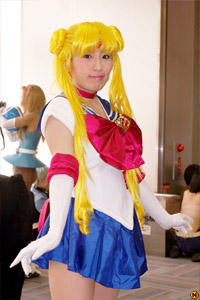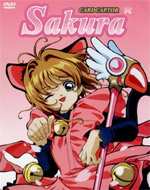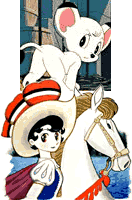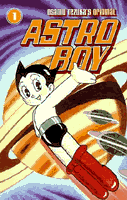Anime Invasion
By Marri Lynn
The new face of Saturday morning TV
 Do you see a wince on your friend's face when you make a passing remark about "Japanimation"? Chances are they're an anime fan, one of a growing number of North Americans finding inspiration and enjoyment in the unique animated material coming out of Japan. You only need to look as far as the television in your own living room to recognize that anime is now a North American network sensation. Pokémon, Digimon, Sailor Moon, Inu Yasha, Witch Hunter Robin, Cardcaptor Sakura, and still more hits have enjoyed air time far from their Eastern birthplace. It's only recently, however, that fans have been able to rejoice the medium's emergence onto mainstream North American markets.
Do you see a wince on your friend's face when you make a passing remark about "Japanimation"? Chances are they're an anime fan, one of a growing number of North Americans finding inspiration and enjoyment in the unique animated material coming out of Japan. You only need to look as far as the television in your own living room to recognize that anime is now a North American network sensation. Pokémon, Digimon, Sailor Moon, Inu Yasha, Witch Hunter Robin, Cardcaptor Sakura, and still more hits have enjoyed air time far from their Eastern birthplace. It's only recently, however, that fans have been able to rejoice the medium's emergence onto mainstream North American markets.
The term anime, as most now know, derives from the Japanese word for animation. Far from being simply Japanese cartoons (a label which is much frowned-upon by anime's devotees), anime has stylistic conventions all its own. The genre has has sprung into a global, multi-billion dollar industry. Today in North America, there are dozens of major annual conventions which attract thousands of fans each year. Merchandise in all shapes and sizes from keychains to action figures to giant plush toys and, of course, comic books and DVDs, are snatched off of the shelf as quickly as they can be imported. Many enthusiasts joke about their addiction to this Japanese phenomenon, and cheerfully liken it to a drug they need their regular fix of, be it in the form of owning their favorite anime in a DVD set to watch when the mood strikes, or collecting a manga series volume by volume. In either case, the price tag can be quite considerable. It's a testament to the genre's popularity that price alone is not usually deterrent enough for fans.
 Most anime fans are now just happy that the products they want are actually available. The hot commodity was once a rare one, and all the more expensive because of its rarity. Overseas orders and hope were all that early fans had; now local comic stores are flooded with a variety of manga and anime DVDs representing every sub-genre of the industry from romance to fantasy, adventure, science fiction, and gothic horror. The sudden proliferation of goods and collectibles owes much to series like Sailor Moon and Pokémon. As the first major serials aired in North America with a large volume of collectible merchandise to their names, they tested the western waters for the fans' desires. It's easy to say that their popularity ushered in the variety that fans enjoy today, and effectively opened the gateways to the continuation of imports.
Most anime fans are now just happy that the products they want are actually available. The hot commodity was once a rare one, and all the more expensive because of its rarity. Overseas orders and hope were all that early fans had; now local comic stores are flooded with a variety of manga and anime DVDs representing every sub-genre of the industry from romance to fantasy, adventure, science fiction, and gothic horror. The sudden proliferation of goods and collectibles owes much to series like Sailor Moon and Pokémon. As the first major serials aired in North America with a large volume of collectible merchandise to their names, they tested the western waters for the fans' desires. It's easy to say that their popularity ushered in the variety that fans enjoy today, and effectively opened the gateways to the continuation of imports.
Tetsuwan Atomu, known to North Americans as Astro Boy, is considered by many to be the wellspring for the creation of the anime genre itself. Like many anime that would continue in its tradition, it began as a manga penned by the now iconographic Osamu Tezuka. Janguru Taitei, known as Kimba, The White Lion aired in the 1960s as the first color television series in Japan. Osamu Tezuka is considered by most to be the progenitor of anime itself. Disney's early animated films, Bambi among them, provided Tezuka with the inspiration for his characters, particularly their large, expressive eyes, which are now the most universally recognized feature of anime characters. Tetsuwan Atomu has such a special place in the hearts of the Japanese that to commemorate Astro Boy's fictional creation date, on April 7th of 2003 the city of Niiza of Saitama prefecture awarded the robot who strove to be a part of humanity an honorary citizenship.



Tezuka Osamu (left of center photo) at work in his studio. Three of his most famous and beloved characters are Jungle Emperor Leo, Princess Knight and Astro Boy (Photos copyright Tezuka Productions)
Osamu's work in the 1960s had paved the way for the serials to come. Many of the 'classics' of the anime genre aired in Japan while North America was watching The Incredible Hulk, Happy Days, and The Brady Bunch. Osamu's large-eyed and Disney-inspired characters proved to be a springboard for the sleeker look that developed in this decade. Lupin III, developed from a French novel series written by Maurice Leblanc, helped establish the archetype of a roguish male lead. Leiji Matsumoto's film Galaxy Express 999, and Yoshiyuki Tomino's television series Mobile Suit Gundam foretold the fascination with spacecraft and futuristic technology that continues in manga and anime to this day. Along with the prevalence of large eyes, mobile humanoid robots are another icon of anime that was established early in the genre's development. The combination of an independent lead male character like Lupin and spacecraft undoubtedly offered inspiration for such space western titles as Cowboy Bebop, Outlaw Star, and Trigun.
